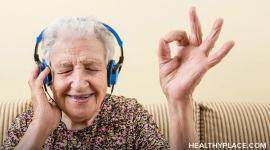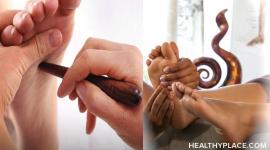Applied Kinesiology for Mental Health Conditions
Learn about applied kinesiology for treatment of learning disabilities and psychological disorders and whether applied kinesiology is effective.
Before engaging in any complementary medical technique, you should be aware that many of these techniques have not been evaluated in scientific studies. Often, only limited information is available about their safety and effectiveness. Each state and each discipline has its own rules about whether practitioners are required to be professionally licensed. If you plan to visit a practitioner, it is recommended that you choose one who is licensed by a recognized national organization and who abides by the organization's standards. It is always best to speak with your primary health care provider before starting any new therapeutic technique.
Background
Applied kinesiology uses muscle testing to identify nutritional deficiencies and health problems; this technique is based on the belief that weakness in certain muscles relates to specific disease states or imbalances in the body. Kinesiologists may use applied kinesiology to diagnose organ dysfunction or energy blockage. Applied kinesiology is also sometimes used to treat allergies, including food and drug allergies. One type of applied kinesiology called edukinesthesia is claimed to be able to detect the cause of learning difficulties and poor concentration. Related terms include kinesitherapy, hydrokinesitherapy, AK muscle testing, Functional Neurologic Assessment, and kinesthetic training.
Applied kinesiology originated in 1964 when the chiropractor George Goodheart Jr. observed that poor posture is sometimes associated with muscles that are weak. He reported that applied kinesiology strengthened muscles and improved posture.
Applied kinesiology is often practiced by chiropractors, although naturopaths, medical doctors, dentists, nutritionists, physical therapists, massage therapists, nurse practitioners and other health providers may also use these techniques. Applied kinesiology is sometimes referred to as contact reflex analysis, dental kinesiology, behavioral kinesiology or muscle testing. Applied kinesiology is different from kinesiology, or biomechanics, which is the study of body movement.
There is limited scientific research on applied kinesiology, and published studies have not established specific links between muscle responses and diseases affecting the organs. Applied kinesiology is not recommended as a sole diagnostic tool in cases when other tests have been shown to be effective. If applied kinesiology is used alone, there may be a risk that disease will remain undetected and untreated. The International College of Applied Kinesiology, founded in the 1970s, has established standards based on the work of Goodheart.
Theory
Applied kinesiology may include specific joint manipulation or mobilization, myofascial (muscle tissue) therapies, cranial techniques, meridian therapy (in Traditional Chinese Medicine, the meridians are channels in the body believed to conduct qi, or elemental forces), good nutrition, dietary management and various reflex procedures. The examiner may test for environmental or food sensitivities by determining what weakened a previously strong muscle. A triad of health factors (chemical, mental, structural) may be used to describe a patient's health status; it has been proposed that an imbalance of one or more of these factors leads to poor health.
Evidence
Scientists have studied applied kinesiology for the following use:
Disease diagnosis
High-quality scientific research of applied kinesiology is limited. Some studies suggest that muscle responses are not related to underlying diseases, and others report that diagnoses made by applied kinesiology practitioners are not consistent and may not accurately reflect nutritional status. Because of weaknesses in available research, the effectiveness of applied kinesiology remains unclear.
Mastalgia (breast pain) in women
Preliminary study suggests that applied kinesiology may be an effective and well tolerated treatment for mastalgia. Further research is needed to confirm these results.
Bronchial asthma
Study results are mixed in this area. Further research is needed before conclusions can be drawn.
Handwriting performance
Preliminary research concludes that kinesthetic training does not improve handwriting or kinesthesis in young children.
Nutritional intolerance
Preliminary research concludes that AK cannot be recommended for diagnosing nutritional intolerance or allergy.
Ménière's disease
Preliminary research suggests that disequilibrium in patients with Ménière's disease may improve with rotational exercises. Further evidence is needed before a clear recommendation can be made.
Unproven Uses
Applied kinesiology has been suggested for many uses, based on tradition or on scientific theories. However, these uses have not been thoroughly studied in humans, and there is limited scientific evidence about safety or effectiveness. Some of these suggested uses are for conditions that are potentially life-threatening. Consult with a health care provider before using applied kinesiology for any use.
| Abdominal pain Apnea Athletic performance Bowel activity Bronchiolitis Cancer Child development Chronic eczema Chronic fatigue syndrome Congenital bowel abnormality Dental conditions Denture displacement Diabetes Diffuse muscular hypotonia Down syndrome Exercise Food allergy (diagnosis or treatment) | Muscle strength Headache Functional impairment Nutritional deficiencies Learning disabilities Myofascial (muscle tissue) release Obesity Osteoporosis Parkinson's disease Positive thinking Preclinical disease states Psychological disorders Spinal stability Spine trauma in infants Thyroid disorders Thyroid eye disease Vertigo |
Potential Dangers
Applied kinesiology is generally believed to be safe in most patients. However, this technique should not be used alone as a diagnostic or therapeutic approach, and it should not delay the time it takes to speak with a qualified health care provider about a potentially life-threatening condition. There may be risks involved in relying solely on applied kinesiology for the treatment of learning disabilities in children, diabetes, food allergies or cancer.
Summary
Applied kinesiology has been suggested for many conditions. But high-quality research is limited, and applied kinesiology has not been shown to be effective for the diagnosis or treatment of any disease.
The information in this monograph was prepared by the professional staff at Natural Standard, based on thorough systematic review of scientific evidence. The material was reviewed by the Faculty of the Harvard Medical School with final editing approved by Natural Standard.
Resources
- Natural Standard: An organization that produces scientifically based reviews of complementary and alternative medicine (CAM) topics
- National Center for Complementary and Alternative Medicine (NCCAM): A division of the U.S. Department of Health & Human Services dedicated to research
Selected Scientific Studies: Applied Kinesiology
Natural Standard reviewed more than 175 articles to prepare the professional monograph from which this version was created.
Some of the more recent studies are listed below:
- Atlas EE. Rehabilitation of children with diffuse muscular hypotonia and neurophysiologic criteria of its effectivness. Vopr Kurortol Fizioter Lech Fiz Kult 2002; (2):26-29.
- Boniver R. Role of kinesitherapy in the treatment of vertigo. Rev Med Liege 2003; 58(11):669-674.
- Caruso W, Leisman G. The clinical utility of force/displacement analysis of muscle testing in applied kinesiology. Int J Neurosci 2001; 106(3-4):147-157.
- Caso Ml. Evaluation of Chapman's neurolymphatic reflexes via applied kinesiology: a case report of low back pain and congenital intestinal abnormality. J Manipulative Physiol Ther 2004; 27(1):66.
- Dunk NM, Chung YY, Comptom DS, et al. The reliability of quantifying upright standing postures as a baseline diagnostic clinical tool. J Manipulative Physiol Ther 2004;27(2):91-96.
- Friedman MH, Weisberg J. Applied kinesiology: double-blind pilot study. J Prosthet Dent 1981;45(3):321-323.
- Garrow JS. Kinesiology and food allergy. Br Med J 1988;296(6636):1573-1574.
- Gregory WM, Mills SP, Hamed HH, Fentiman IS. Applied kinesiology for treatment of women with mastalgia. Breast 2001; 10(1):15-19.
- Grossi JA. Effects of an applied kinesiology technique on quadriceps femoris muscle isometric strength. Phys Ther 1981;61(7):1011-1016.
- Haas M, Peterson D, Hoyer D, Ross G. Muscle testing response to provocative vertebral challenge and spinal manipulation: a randomized controlled trial of construct validity. J Manipulative Physiol Ther 1994; 17(3):141-148.
- Jacobs GE, Franks TL, Gilman PG. Diagnosis of thyroid dysfunction: applied kinesiology compared to clinical observations and laboratory tests. J Manipulative Physiol Ther 1984;7(2):99-104.
- Katic R. Identification of biomotor structures as a precondition for programming kinesiologic education in children aged seven to nine years. Coll Antropol 2003;27(1):351-360.
- Kenney JJ, Clemens R, Forsythe KD. Applied kinesiology unreliable for assessing nutrient status. J Am Diet Assoc 1988;88(6):698-704.
- Klinkoski B, Leboeuf C. A review of the research papers published by the International College of Applied Kinesiology from 1981 to 1987. J Manipulative Physiol Ther 1990;13(4):190-194.
- Lawson A, Calderon L. Interexaminer agreement for applied kinesiology manual muscle testing. Percept Mot Skills 1997 Apr;84(2):539-546.
- Ludtke R, Kunz B, Seeber N, Ring J. Test-retest reliability and validity of the kinesiology muscle test. Complement Ther Med 2001;9(3):141-145.
- Mickleborough TD, Murray RL, Ionescu AA, et al. Fish oil supplementation reduces severity of exercise-induced bronchoconstriction in elite athletes. Am J Respir Crit Care Med 2003;168(10):1181-1189.
- Moncayo R, Moncayo H, Ulmer H, et al. New diagnostic and therapeutic approach to thyroid-associated orbitopathy based on applied kinesiology and homeopathic therapy. J Altern Complement Med 2004;10(4):643-650.
- Nyabenda A, Briart C, Deggouj N, et al. [Benefit of rotational exercises for patients with Meniere's syndrome, method used by the ENT department of St-Luc university clinic]. Ann Readapt Med Phys 2003;46(9):607-614.
- Pothmann R, von Frankenberg S, Hoicke C, et al. Evaluation of applied kinesiology in nutritional intolerance of childhood. Forsch Komplementarmed Klass Naturheilkd 2001; 8(6):336-344.
- Schmitt WH Jr, Yanuck SF. Expanding the neurological examination using functional neurologic assessment: part II neurologic basis of applied kinesiology. Int J Neurosci 1999; 97(1-2):77-108.
- Sudsawad P, Trombly CA, Henderson A, Tickle-Degnen L. Testing the effect of kinesthetic training on handwriting performances in first-grade students. Am J Occup Ther 2002; 56(1):26-33.
- Surovenko TN, Iashchuk AV, Iansons TIa, Ezhov SN. Efficiency of kinesi- and hydrokinesitherapy in children with bronchial asthma. Vopr Kurortol Fizioter Lech Fiz Kult 2003; (3):29-32.
- Teuber SS, Porch-Curren C. Unproved diagnostic and therapeutic approaches to food allergy and intolerance. Curr Opin Allergy Clin Immunol 2003; 3(3):217-221.
- Tashiro MT, Orlandi R, Martins RC, dos Santos E. New therapeutic trends in nursing-natural therapies-assistance programs. Rev Bras Enfrm 2001;54(4);658-667.
- Triano JJ. Muscle strength testing as a diagnostic screen for supplemental nutrition therapy: a blind study. J Manipulative Physiol Ther 1982;5(4):179-182.
back to: Alternative Medicine Home ~ Alternative Medicine Treatments
APA Reference
Staff, H.
(2008, November 22). Applied Kinesiology for Mental Health Conditions, HealthyPlace. Retrieved
on 2025, November 14 from https://www.healthyplace.com/alternative-mental-health/treatments/applied-kinesiology-for-mental-health-conditions


